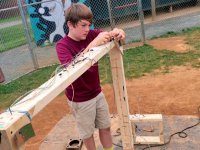A Student Maker and the Birth of a Startup
A reluctant middle school student responded to a summer maker challenge and ended up demonstrating his sports training product prototype at a White House tech innovation fair.
I always felt trapped in school, with teachers telling me what to do and feeding me information that did not make sense. Honestly, I hated school and rarely paid attention or did homework. Obviously, I was mad when my mother forced me to go to my middle school's Summer Maker Camp. It sounded extremely boring. More school in the summer? I think not.
Within the first hour of camp, the teachers presented us with a challenge: Create a project related to something you love, incorporate some type of technology, and possibly start a business around it. I never did anything like this in school before. It was open-ended, and I could do it my own way, instead of sitting at a desk and being told to open to page 84. This excited me. I could work on a project that I chose!
Designing and Pitching a Product
As a baseball catcher and pitcher, I have experienced a common problem: Younger players have difficulty finding the strike zone. I wanted to solve this problem by making a practice strike zone for pitchers. I thought about building a frame. I considered different materials and finally decided to use wood. We had a lot of it in the shop area, and I felt comfortable working with it thanks to my sixth-grade engineering class. A strike zone measures 28 inches square, so my frame would be about four feet by five feet to contain the strike zone. I needed a way to sense the balls coming through the frame, so I researched different methods and patents on already-made practice machines. My team and I found that using laser pointers and photoresistors worked well and were pretty easy to set up. We named it Strikey Sensors! I became so excited about working on Strikey Sensors that I even skipped baseball camp to have more time at school. I never expected to enjoy anything at school so much.
In the fall, my engineering teacher invited our classes to participate in Charlottesville's StartUp Weekend, hosted by our district, Albemarle County Public Schools. I was one of the only students who decided to go. That weekend, I delivered a pitch about my summer idea to maybe 50 people, but it was not voted to continue to the next stage of the competition. That did not stop me -- I recruited team members to help bring my project to life. My startup team spent two and a half days learning about microcontrollers and building a prototype. An Arduino helped sense the laser pointers and photoresistors. We built a working model with two lasers in each direction to sense a ball or a strike depending on the number of lasers that broke in the grid. A light under the word "ball" or "strike" lit up accordingly. Then, I presented this prototype to entrepreneur judges from all around Virginia. To my surprise, I won the event with the best new idea, beating almost ten other teams comprised of people who were all older than me!
I continued to work on my project throughout the year in my engineering and science classes, making it stronger and more accurate. I collaborated with other students to create a logo and videos describing my project. Even after school, I stayed to keep working on this because I wanted to further my entrepreneurial pursuit. Although it started as a school project, it really mattered to me. In the spring, the Charlottesville Business Innovation Council (CBIC) nominated me for Student Entrepreneur of the Year, along with a high school student and university student -- and I won!
Recognition and Iteration
This summer, I was invited to take a newer prototype to the White House. My engineering teacher and I shared Strikey Sensors with many government officials and businesspeople at a Career and Technical Education Innovation Fair. The First Lady spoke about some cool things going on around the nation, and gave a shout-out to my project! This was exciting as I was the only middle school student there. Most people probably would not expect me to be presenting a school project at the White House.
This July, I much more enthusiastically returned to Summer Maker Camp and worked on another version of Strikey Sensors that looks much cleaner and is being rewired. I still have to work on the coding for the Arduino microcontroller. Once complete, I think this will be the best prototype so far. I hope to bring Strikey Sensors to the market and possibly create a sports technology business. I am even helping one of my friends on creating a project of his own.
I learned about coding, electronics, woodworking, patent searches, how to communicate with a variety of people, and how to have fun in school. This whole experience gave me a reason to go to school. I now also have confidence to build all kinds of cool stuff for myself and other people, using 3D printers, computer-aided design (CAD), laser cutters, and other cool equipment. I encourage other kids to try something new and create their own products by identifying needs and coming up with ideas to solve them.
Albemarle County Public Schools
Enrollment
13677 | PublicPer Pupil Expenditures
$12154 DistrictFree / Reduced Lunch
28%DEMOGRAPHICS:
10% Students with disabilities
This blog post is part of our Schools That Work series, which features key practices from Albemarle County Public Schools.
